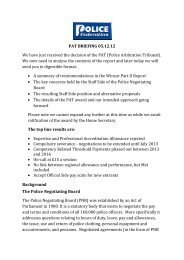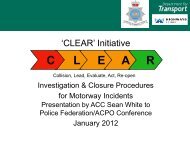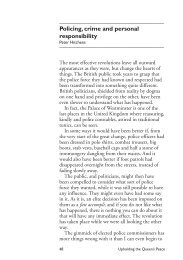Policing UK 2013 - Police Federation
Policing UK 2013 - Police Federation
Policing UK 2013 - Police Federation
You also want an ePaper? Increase the reach of your titles
YUMPU automatically turns print PDFs into web optimized ePapers that Google loves.
SPONSORED FEATURE<br />
The police solution framework<br />
was developed and is continually<br />
revised in collaboration with police<br />
customers. It is not designed as a ‘big<br />
bang’ IT replacement program as the<br />
architectural principles are based on<br />
phased implementation while being<br />
sympathetic to the complexities of legacy<br />
systems. The solution framework is built<br />
on open standards intended to integrate<br />
with key third party technologies and<br />
reuse where practicable components of<br />
the legacy system.<br />
<strong>Policing</strong> is based on historic principles<br />
like the ‘Judges Rules’ 1 , Peelian Principles<br />
2<br />
and legislation designed to regulate<br />
the unique role of a constable who is<br />
entrusted to enforce laws or use lethal<br />
force when there is a serious threat to life.<br />
In this era of the information<br />
economy, a constable or more generally<br />
front line operational police and those<br />
who support them are sometimes<br />
disempowered to perform this unique,<br />
historic role. This is often due to IT<br />
systems not enabling their work or<br />
providing relevant functionality to<br />
deliver the right information to perform<br />
their function.<br />
<strong>Police</strong> IT systems in operation today<br />
have generally been designed before<br />
the advent of online customers, social<br />
media, tablet devices and new forms<br />
of mobile working. This phenomenon<br />
is frequently referred to as ‘front line<br />
information poverty’ as employees<br />
cannot get access to the information<br />
needed to make informed decisions,<br />
sometimes in high risk situations. It often<br />
results in simple tasks not being able to<br />
be completed in the field, necessitating<br />
a trip back to an office, thereby taking<br />
scarce resources off the street.<br />
For the customer or a citizen this may<br />
result in delays to access to justice or<br />
unnecessary bureaucratic processes when<br />
interacting with the police.<br />
Organisational issues<br />
This is a symptom of a deeper<br />
organisational IT problem confronted by<br />
police services in many countries around<br />
the world. There are a multiplicity of<br />
reasons why police IT systems appear to<br />
be embedded in a different era, but some<br />
common themes are hundreds of legacy<br />
applications servicing the organisation.<br />
Similarly, the IT technical infrastructure<br />
is not capable of meeting the demands<br />
of end users or it does not possess the<br />
ability to technically support modern<br />
police service delivery in an environment<br />
of information overload.<br />
The IT systems needed to support a<br />
large police force are not significantly<br />
different from the capabilities needed<br />
by a small force as they perform similar<br />
functions but on a different scale. This<br />
raises the question of affordability, with<br />
some large organisations evaluating<br />
cloud computing to modernize, while<br />
smaller police forces, which are the<br />
victims of organisational fragmentation,<br />
are turning to collaboration with other<br />
forces to gain access to contemporary<br />
technology.<br />
Shared responsibility<br />
<strong>Police</strong> ICT strategy development and<br />
enterprise solution delivery is very much<br />
a shared responsibility between police<br />
executive business professionals, chief<br />
information officers, and representatives<br />
from the back office and front line police.<br />
It also requires working in a close<br />
and well-structured partnership with<br />
key technology product vendors such<br />
as Oracle, systems integrators and<br />
consulting delivery partners. Through<br />
these partnerships, police will learn<br />
about advances in ICT and gain<br />
valuable information about how to<br />
approach and what to expect from<br />
business and IT modernisation and<br />
transformation programs.<br />
These partnerships will provide<br />
industry invaluable insight into<br />
understanding police service delivery<br />
requirements and organisational<br />
resourcing challenges. Both the police<br />
and industry must take a long-term<br />
view on this important public-private<br />
partnership. It also means both sides<br />
investing in the future. Ultimately, this is<br />
about delivering a quality service to the<br />
customers, giving police the technology<br />
they need to do their job and provide<br />
value for money to government. n<br />
For further information<br />
Visit www.oracle.com<br />
<strong>Police</strong> IT systems in operation today have<br />
generally been designed before the advent<br />
of online customers, social media, tablet<br />
devices and new forms of mobile working<br />
1<br />
Judges Rules see http://en.wikipedia.org/wiki/Judges%27_<br />
Rules<br />
2<br />
Peelian Principles see http://en.wikipedia.org/wiki/<br />
Peelian_Principles
















